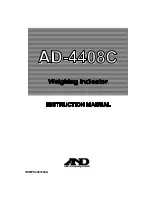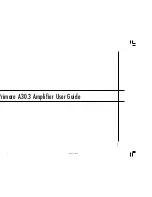
3
Please ensure your amplifier is switched to the correct voltage for your country. If unsure please consult your dealer.
1 2 3 4 4 4 5 6 7 8
Rear Panel
1.
Send & Return Sockets
The effects loop, send and return jack sockets (rear of amplifier) are intended for use with outboard
pedals or rack equipment such as delay, reverb and chorus etc. Effects such as wah wah, fuzz, distortion
etc, would probably be best placed between the guitar and amplifier input! The effects loop is wired in
series with the pre-amp signal and is completely valve driven!
2.
Channel Footswitch Socket
The footswitch jack socket (rear of amplifier) enables channel switching using any latching footswitch.
Note: The footswitch will override the channel, clean/dirty switch.
3.
Reverb Footswitch Socket
Attaching an optional footswitch to this socket will allow you to remotely switch the reverb
effect on and off.
4.
Speaker Outputs
When using a single Orange 16 ohm speaker cabinet, (i.e. PPC412 or PPC212), attach it to the
16 ohm output socket on your amplifier. When using two Orange 16 ohm speaker cabinets attach each
one to a separate 8 ohm output socket on your amplifier.
When using a single 8 ohm cabinet attach it to either one of the two 8 ohm output sockets
on your amplifier.
WARNING:
Never use two 8 ohm cabinets at the same time.
When using a Rockerverb 50 combo with a 16 ohm extension speaker, disconnect the internal
speaker from the 16 ohm socket and reconnect to one of the two 8 ohm sockets. Connect the
extension speaker to the other 8 ohm socket.
WARNING:
Orange Rockerverb amplifiers should not be used with 4 ohm speakers.
5.
Output Valve Selector
(Rockerverb 100 only). Although both the Rockerverb 50 and 100 MKII come fitted and biased with
EL34’s, the output valve selection switch (rear of amplifier) allows for the use of other output valve types,
such as 6L6’s, 6550’s and KT88’s. Note: This switch only puts the amplifier bias in the region for the above
listed valve types! Fine bias tuning for the actual set of output valves to be fitted, needs to be performed
by a qualified service technician!
6.
Mains Socket & Fuse Holder
This is where your mains lead plugs in. Also the mains fuse is located here.
T2Amp 220/230-240 VAC (T5Amp 100/120 VAC) on 50 watt model.
T 3.15Amp 220/230-240 VAC (T6.3Amp 100/120 VAC on 100 watt model.
7.
Mains Voltage Switch
Switches amp between 220V and 240V or 100V and 120V. This should be set to the mains
electricity voltage used in the country where the amplifier is to be operated.
8.
HT Fuse Holder
This is where your HT fuse is located.
2 x T500MA on 50 watt model.
1 x T1Amp on 100 watt model.
SPEAKER OUTPUTS
ORANGE
LONDON ENGLAND
100 WATTS RMS
ROCKERVERB 100 MKII
AMPLIFIER HEAD
RK100HMII-
SEND
RETURN CHANNEL REVERB
SWITCHES
50/60 Hz
VAC
8
RK100H
MK II
8
16
Output: EL34 x 4, 6CA7 X 4, KT88 X 4, 6550X 4, or 6L6GC X 4
VALVES LEFT TO RIGHT FROM REAR
Preamp: Front Row:ECC83 (12AX7) ECC83 (12AX7) ECC83 (12AX7) ECC81 (12AT7)
Preamp: Rear Row:ECC81 (12AT7) ECC81 (12AT7) ECC83 (12AX7)
WARNING:
TO REDUCE THE RISK OF FIRE OR ELECTRIC
SHOCK, THIS APPARATUS SHOULD NOT BE EXPOSED TO RAIN
OR MOISTURE AND OBJECTS FILLED WITH LIQUIDS SUCH AS
VASES, SHOULD NOT BE PLACED ON THIS APPARATUS.
TO PREVENT THE RISK OF FIRE HAZARD, REPLACE WITH
SAME TYPE 250 VOLT FUSE.
AVIS:
DANS LE BUT DE REDUIRE LES RISQUES D’INCENDIE
OU DE DECHARGE ELECTRIQUE, CET APPREIL NE DOIT PAS
ETRE EXPOSE A LA PLUIE OU A L’HUMIDITE ET AUCUN OBJET
REMPLI DE LIQUIDE, TEL QU’UN VASE, NE DOIT ETRE POSE
SUR CELUI-CI. REMPLACER PAR UNFUSIBLE DE MEME TYPE
ET DE 250 VOLTS.
CAUTION
RISK OF ELECTRIC SHOCK
DO NOT OPEN
WARNING!
ALWAYS CONNECT AMPLIFIER
TO CORRECT SPEAKER LOAD
BEFORE POWERING UP
POWER RATING:
575 VA
OUTPUT VALVE
SELECTION
KT88
6550
6L6GC
EL34
6CA7
MAINS FUSE
220/230-240V:
T3.15A H
100/120V:
T6.3A H
3184582
T1A H
HT FUSE
1 2
3
4
5
6 7 8
9
10 11 12 13
14
Front Panel
1.
Power/Standby Switch
Power up the amplifier by switching the power, off/standby/on switch to the standby position
and then switch to on, after 2 minutes.
2.
Channel Switch
The channel, clean/dirty switch, switches from the clean channel to the dirty channel, when
there is no footswitch attached.
3.
Power Indicator Lamp
4.
Reverb Control
Controls the Reverb level for both channels
5.
Volume Control
The volume control adjusts the output volume of the dirty channel.
High levels of volume will heavily overdrive the output stage!
6.
Treble Control
The treble control adjusts the treble response of the dirty channel.
7.
Middle Control
The middle control adjusts the midrange response of the dirty channel.
8.
Bass Control
The bass control adjusts the bass response of the dirty channel.
9.
Gain Control
The gain control adjusts the gain of the dirty channel. High levels of gain will heavily overdrive
the pre-amp and may sometimes be uncontrollable, especially when used at high volume
levels! This will be more apparent when used as a combo!
10.
Treble Control
The treble control adjusts the treble response of the clean channel.
Note: When all three tone controls are set to zero, there will be no sound from
the clean channel!
11.
Middle Control
The middle control adjusts midrange response of the clean channel.
12.
Bass Control
The bass control adjusts the bass response of the clean channel.
13.
Volume Control
The volume control adjusts the volume of the clean channel. High levels will overdrive the
output stage in a vintage manner!
14.
Input Socket
For both channels
STANDBY
OFF
ON
DIRTY
CLEAN
INPUT
GAIN
BASS
MIDDLE
TREBLE
VOLUME
CHANNEL
POWER
REVERB
TREBLE
BASS
VOLUME
MIDDLE
DIRTY CHANNEL
CLEAN CHANNEL
























